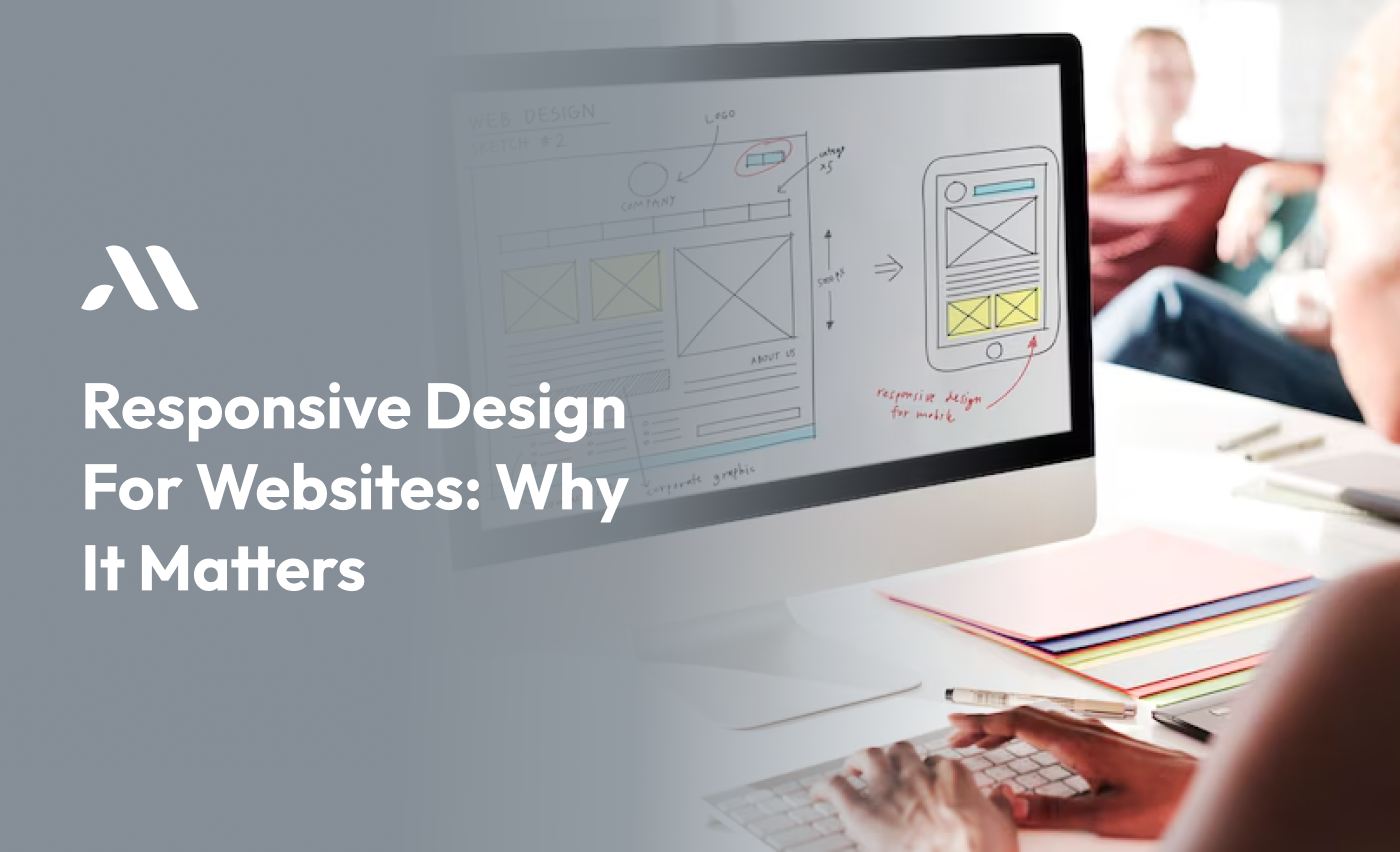Almost everyone has a smartphone, tablet, or computer in today's digital world. People use these devices to search, shop, and browse the internet. But every device has a different screen size, which makes it important for websites to look good and work well on any screen. This is where Responsive Design for Websites comes in.
Responsive design is how websites adjust and adapt to fit any screen size, whether a small phone or a big computer monitor. Responsive design will make your website user-friendly and look great for everyone. Here’s everything you need to know about why responsive design matters and how it can make a difference in website development.
Mobile traffic: Around 55% of web traffic comes from mobile devices.
Bounce rate: Websites without responsive design have higher bounce rates, meaning visitors leave quickly.
User preference: Over 85% of people say they prefer mobile-friendly websites.
SEO impact: Google ranks mobile-friendly sites higher in search results.
What Is Responsive Design for Websites?
Responsive design means that a website changes its layout and design based on the device it’s being viewed on. Imagine a website that looks big and wide on a computer, but changes to fit a small phone screen without users needing to zoom in or scroll sideways. That’s responsive design!
Using responsive design in website development helps a website automatically adjust its size, images, text, and buttons to look perfect on any device. Whether people are using a smartphone, tablet, or desktop computer, they’ll have a smooth experience thanks to responsive design.
Why Does Responsive Design for Websites Matter?
Responsive design is not just about making a website look pretty. It affects how people feel when they visit a site. If a website doesn’t fit their device, users might leave quickly. Here are some big reasons why responsive design is important:
1. Better User Experience
Responsive design makes sure visitors have a great experience on your website. When a website looks good and works well, people enjoy using it. They’re more likely to stay on the site longer, read information, and explore what you have to offer. A good user experience is important in building trust with visitors.
Remember: A website with a responsive design is easier to read, navigate, and interact with, no matter what device people use.
2. Higher Search Engine Rankings
Search engines, like Google, prefer websites that work well on all devices. Google considers responsive design a ranking factor. This means websites with responsive design can rank higher on Google search results. Higher rankings help more people find the website, which brings more visitors and potential customers.
3. More Conversions
Responsive design can help businesses get more sales, sign-ups, and inquiries. When users have an easy experience, they’re more likely to complete an action, like buying a product, filling out a form, or subscribing to a newsletter. When users don’t struggle with zooming or finding buttons, they are more willing to convert from visitors to customers.
4. Cost-Efficiency in Website Development
Building separate websites for mobile and desktop devices can be costly and time-consuming. With responsive design, there’s no need for multiple websites. Instead, a single responsive website adjusts automatically to fit any screen. This makes website development easier, saves money, and reduces the time needed to maintain multiple sites.
Tips for Creating a Great Responsive Design for Websites
Creating a responsive website doesn’t have to be complicated. Here are some helpful tips to get started:
1. Use a Flexible Grid Layout
A flexible grid layout divides the page into sections and scales them according to screen size. Instead of setting a fixed width, a flexible grid automatically resizes elements. This ensures that images, text, and other content stay in proportion on any device.
2. Optimize Images for Different Screens
Large images can slow down your website, especially on mobile devices. In responsive design, use smaller images for mobile and high-quality images for larger screens. This not only speeds up the site but also makes it look better on different devices.
Note: Google considers page speed as an important factor for ranking websites, so optimizing images is essential!
3. Design for Touchscreens
Many people use touchscreen devices like smartphones and tablets. Make sure buttons, links, and interactive elements are large enough for people to tap on easily. This can improve the user experience for people browsing on phones or tablets.
4. Choose Responsive Fonts and Text Sizes
The text should be easy to read on all devices. Responsive design adjusts text size based on the screen width, so it’s always readable. This is especially important for mobile devices, where small text can be hard to read.
5. Test on Multiple Devices
Before launching a responsive website, test it on multiple devices to make sure everything looks and works as expected. Checking the site on phones, tablets, and computers will show if any adjustments are needed. Testing can help you catch issues that may not appear on just one device.
“Responsive design isn’t just about shrinking a website down. It’s about adapting content to create a positive user experience on any device.”
Choosing the Right Website Development Company for Responsive Design
If you want a responsive website but aren’t sure where to start, a website development company can help. Professional website developers are skilled at creating responsive designs that look good on all devices. Here’s what to look for in a website development company:
Experience with Responsive Design: Check if the company has created responsive websites before. Look at their portfolio to see examples of their work on different devices.
Understanding of SEO: A good website development company knows that SEO is important. They will build a responsive website that ranks well on search engines.
Communication and Support: Responsive design is an ongoing process. Choose a company that offers support and can make updates as new devices and screen sizes come out.
Use of Modern Tools: Ask if they use the latest web design tools and technologies to ensure the site is responsive. Technologies like HTML5, CSS3, and JavaScript are essential for creating flexible designs.
Choosing a skilled website development company can save you time, stress, and money while providing a website that adapts to all devices.
Also Read - How a Responsive Website Can Boost Your Online Taxi Business
Benefits of Responsive Design for Different Industries
Responsive design is valuable for all types of businesses and organizations. Here are some industries that benefit greatly from responsive design:
Retail and eCommerce: A responsive site makes it easy for customers to shop from any device. With so many people shopping on their phones, it’s crucial to have a responsive design for smooth browsing and checkout.
Education and Non-profits: Many students and donors access websites on mobile devices. A responsive design ensures they can find information and donate easily.
Blogs and News Sites: People read news and blog articles on the go. A responsive site makes reading easy, whether they’re on a phone, tablet, or computer.
Responsive Design for Websites: Final Thoughts
In today’s world, having a website that works well on all devices is not just nice to have; it’s a must-have. Responsive Design for Websites is essential for providing a better user experience, ranking higher on search engines, increasing conversions, and saving time and money. Whether you’re a business, a school, or a blogger, responsive design helps you reach a wider audience and keeps visitors happy.
Remember: Responsive design is about making your website accessible to everyone, everywhere. It’s an investment that pays off by helping your site perform better on any device.
Ready to make your website look amazing on any device? At MicraSol, we build websites and apps that work perfectly on phones, tablets, and computers. With our responsive design, your site will look great and be easy to use for everyone. Let’s get started on your project today!
When planning your next website project, keep responsive design at the top of your list. With the help of a trusted website development company, you can create a beautiful, functional website that people will love using on any device.
FAQS
What is Responsive Design for Websites?
Responsive design is a way of building a website so that it changes to fit any screen size. This means that a website will look good and work well whether you’re on a smartphone, tablet, or computer. It automatically adjusts text, images, and buttons, making it easy to use on any device.
Why is Responsive Design Important?
Responsive design is important because it makes websites easier for everyone to use. When people have a good experience on a website, they’re more likely to stay, read, and explore. It also helps businesses because Google ranks responsive websites higher, meaning more people can find them.
How Does Responsive Design Help My Website on Google?
Google likes websites that are mobile-friendly, and responsive design is mobile-friendly. When a website adjusts to fit any screen, Google gives it a better ranking. This helps people find your website more easily when they search for things related to your business or content.
Is Responsive Design Expensive?
Responsive design can save money in the long run. Instead of building separate websites for mobile and desktop, you just need one website that fits all devices. It may cost a little more to set up, but it saves money on future updates and is easier to maintain.
How Can I Tell if My Website is Responsive?
The easiest way to check if a website is responsive is to open it on different devices, like a phone, tablet, and computer. If the website changes size and looks good on each device, it’s responsive! You can also resize the browser window on a computer; if the website adjusts as you make the window smaller, it’s responsive.








